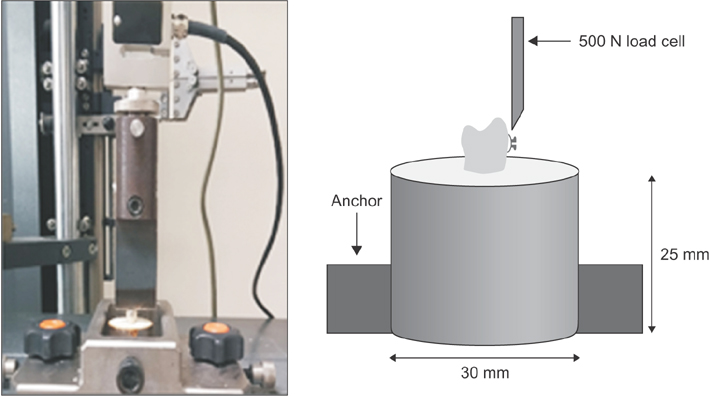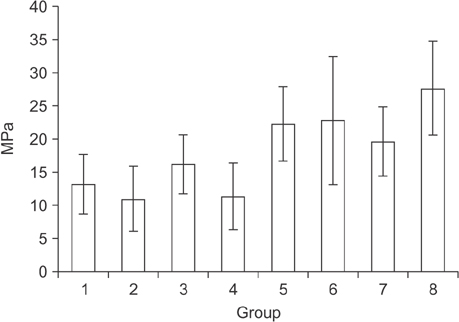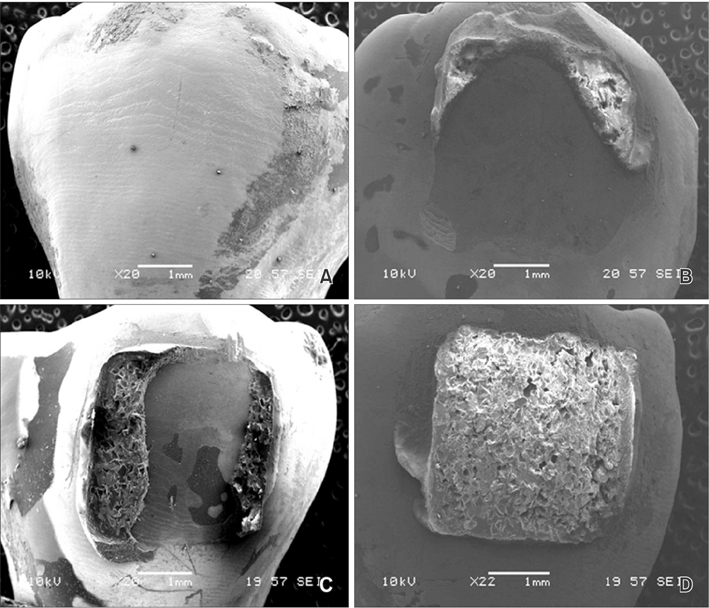Korean J Orthod.
2016 Nov;46(6):364-371. 10.4041/kjod.2016.46.6.364.
Comparison of the bonding strengths of second- and third-generation light-emitting diode light-curing units
- Affiliations
-
- 1Department of Orthodontics, College of Dentistry, Wonkwang University, Iksan, Korea.
- 2Department of Orthodontics, Wonkwang University Daejeon Dental Hospital, Daejeon, Korea. esther0705@hanmail.net
- KMID: 2426680
- DOI: http://doi.org/10.4041/kjod.2016.46.6.364
Abstract
OBJECTIVE
With the introduction of third-generation light-emitting diodes (LEDs) in dental practice, it is necessary to compare their bracket-bonding effects, safety, and efficacy with those of the second-generation units.
METHODS
In this study, 80 extracted human premolars were randomly divided into eight groups of 10 samples each. Metal or polycrystalline ceramic brackets were bonded on the teeth using second- or third-generation LED light-curing units (LCUs), according to the manufacturers' instructions. The shear bond strengths were measured using the universal testing machine, and the adhesive remnant index (ARI) was scored by assessing the residual resin on the surfaces of debonded teeth using a scanning electron microscope. In addition, curing times were also measured.
RESULTS
The shear bond strengths in all experimental groups were higher than the acceptable clinical shear bond strengths, regardless of the curing unit used. In both LED LCU groups, all ceramic bracket groups showed significantly higher shear bond strengths than did the metal bracket groups except the plasma emulation group which showed no significant difference. When comparing units within the same bracket type, no differences in shear bond strength were observed between the second- and third-generation unit groups. Additionally, no significant differences were observed among the groups for the ARI.
CONCLUSIONS
The bracket-bonding effects and ARIs of second- and third-generation LED LCUs showed few differences, and most were without statistical significance; however, the curing time was shorter for the second-generation unit.
Figure
Reference
-
1. Flury S, Lussi A, Hickel R, Ilie N. Light curing through glass ceramics with a second- and a third-generation LED curing unit: effect of curing mode on the degree of conversion of dual-curing resin cements. Clin Oral Investig. 2013; 17:2127–2137.
Article2. Price RB, Felix CM, Whalen JM. Factors affecting the energy delivered to simulated class I and class v preparations. J Can Dent Assoc. 2010; 76:a94.3. Dall’Igna CM, Marchioro EM, Spohr AM, Mota EG. Effect of curing time on the bond strength of a bracket-bonding system cured with a light-emitting diode or plasma arc light. Eur J Orthod. 2011; 33:55–59.
Article4. Swanson T, Dunn WJ, Childers DE, Taloumis LJ. Shear bond strength of orthodontic brackets bonded with light-emitting diode curing units at various polymerization times. Am J Orthod Dentofacial Orthop. 2004; 125:337–341.
Article5. Rueggeberg FA. State-of-the-art: dental photocuring--a review. Dent Mater. 2011; 27:39–52.
Article6. Lee JH, Lee M, Kim KN, Hwang CJ. Resin bonding of metal brackets to glazed zirconia with a porcelain primer. Korean J Orthod. 2015; 45:299–307.
Article7. Lee JY, Kim JS, Hwang CJ. Comparison of shear bond strength of orthodontic brackets using various zirconia primers. Korean J Orthod. 2015; 45:164–170.
Article8. Mills RW, Jandt KD, Ashworth SH. Dental composite depth of cure with halogen and blue light emitting diode technology. Br Dent J. 1999; 186:388–391.
Article9. Uhl A, Sigusch BW, Jandt KD. Second generation LEDs for the polymerization of oral biomaterials. Dent Mater. 2004; 20:80–87.
Article10. Flury S, Lussi A, Hickel R, Ilie N. Light curing through glass ceramics: effect of curing mode on micromechanical properties of dual-curing resin cements. Clin Oral Investig. 2014; 18:809–818.
Article11. Spranley TJ, Winkler M, Dagate J, Oncale D, Strother E. Curing light burns. Gen Dent. 2012; 60:e210–e214.12. Bruzell Roll EM, Jacobsen N, Hensten-Pettersen A. Health hazards associated with curing light in the dental clinic. Clin Oral Investig. 2004; 8:113–117.
Article13. Jandt KD, Mills RW. A brief history of LED photopolymerization. Dent Mater. 2013; 29:605–617.
Article14. Malkoç S, Uysal T, Uşümez S, Işman E, Baysal A. In-vitro assessment of temperature rise in the pulp during orthodontic bonding. Am J Orthod Dentofacial Orthop. 2010; 137:379–383.
Article15. Cha JY, Lee KJ, Park SH, Kim TW, Yu HS. Comarison of the shear bond strength of brackets in regards to the light curing source. Korean J Orthod. 2006; 36:198–206.16. Mavropoulos A, Cattani-Lorente M, Krejci I, Staudt CB. Kinetics of light-cure bracket bonding: power density vs exposure duration. Am J Orthod Dentofacial Orthop. 2008; 134:543–547.
Article17. Kang J, Jun S, Kim J, Kim J, Yoo S. Evaluation of new LED curing light on resin composite polymerization. J Korean Acad Pediatr Dent. 2014; 41:152–156.
Article18. Kwon TH, Kang JM, Chang NY, Kang KH. Shear bond strength of ceramic brackets bonded with antimicrobial monomer-containing self-etching primer. Korean J Orthod. 2011; 41:16–24.
Article19. Judy RH, Dunn WJ, Patel AB, Swanson T. Effective single-charge end point of cordless light-emitting diode light-curing units. Am J Orthod Dentofacial Orthop. 2006; 130:378–384.
Article20. International Organization for Standardization. ISO/TS 11405: 2003(E). Dentistry: Dental materials: testing of adhesion to tooth structure. Geneva, Switzerland: World Health Organization;2003.21. Artun J, Bergland S. Clinical trials with crystal growth conditioning as an alternative to acid-etch enamel pretreatment. Am J Orthod. 1984; 85:333–340.
Article22. Wiggins KM, Hartung M, Althoff O, Wastian C, Mitra SB. Curing performance of a new-generation light-emitting diode dental curing unit. J Am Dent Assoc. 2004; 135:1471–1479.
Article23. Reynolds IR. A review of direct orthodontic bonding. Br J Orthod. 1975; 2:171–178.
Article24. Eslamian L, Borzabadi-Farahani A, Mousavi N, Ghasemi A. A comparative study of shear bond strength between metal and ceramic brackets and artificially aged composite restorations using different surface treatments. Eur J Orthod. 2012; 34:610–617.
Article25. Reddy YG, Sharma R, Singh A, Agrawal V, Agrawal V, Chaturvedi S. The shear bond strengths of metal and ceramic brackets: An in-vitro comparative study. J Clin Diagn Res. 2013; 7:1495–1497.
Article26. Eliades T, Johnston WM, Eliades G. Direct light transmittance through ceramic brackets. Am J Orthod Dentofacial Orthop. 1995; 107:11–19.
Article27. Graber TM, Eliades T, Athanasiou AE. Risk management in orthodontics: Experts’ guide to malpractice. Surrey, UK: Quintessence Books;2004. p. 25.28. Bishara SE, Fehr DE. Ceramic brackets: something old, something new, a review. Semin Orthod. 1997; 3:178–188.
Article
- Full Text Links
- Actions
-
Cited
- CITED
-
- Close
- Share
- Similar articles
-
- The shear bond strength and adhesive failure pattern in bracket bonding with different light-curing methods
- Comparison of light transmittance in different thicknesses of zirconia under various light curing units
- Dentin bond strength of bonding agents cured with light emitting diode
- Effect of infection control barrier thickness on light curing units
- Evaluation of High-power Light Emitting Diode Curing Light on Sealant Polymerization




